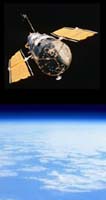| . |  |
. |
 Artificial "Eyelids" Protect SpySats From Lasers
Artificial "Eyelids" Protect SpySats From LasersParis - March 15, 2000 - Spy satellites may soon be fitted with artificial "eyelids" to protect them from the blinding flash of enemy lasers, New Scientist reports in its upcoming issue on Saturday. A powerful laser beam sent from the ground is enough to cripple the extremely delicate optical sensors with which orbiting military satellites capture highly-detailed pictures of enemy sites. A company in North Carolina, MCNC, has now developed eyelids that can close in a split second to protect the sensors, the British scientific weekly says. "Basically, you don't want to put a billion-dollar satellite into orbit if someone can put it out of action with a laser the next day," MCNC engineer Gary McGuire explained. The shields are made from a thin sheet of glass that is covered with transparent electrodes made from an oxide of indium and tin. Attached like a hinge to the edge of each transparent electrode is an opaque electrode. By passing opposite voltages to the two sets, an electrostatic attraction is created, pulling the opaque electrodes down and shutting the eyelid. Switch off the voltage, and the eyelid springs back up. In tests, the eyelid was able to open and close 4,000 times a second, although this speed will have to be improved many times more in order to protect sensors from an unexpected laser attack.
This article appeared in the March 18 issue of New Scientist New Scientist. Copyright 1999 - All rights reserved. The material on this page is provided by New Scientist and may not be published, broadcast, rewritten or redistributed without written authorization from New Scientist.
MILSPACE
Lasers At SpaceDaily
|
| |||||||||
| The content herein, unless otherwise known to be public domain, are Copyright 1995-2016 - Space Media Network. All websites are published in Australia and are solely subject to Australian law and governed by Fair Use principals for news reporting and research purposes. AFP, UPI and IANS news wire stories are copyright Agence France-Presse, United Press International and Indo-Asia News Service. ESA news reports are copyright European Space Agency. All NASA sourced material is public domain. Additional copyrights may apply in whole or part to other bona fide parties. Advertising does not imply endorsement, agreement or approval of any opinions, statements or information provided by Space Media Network on any Web page published or hosted by Space Media Network. Privacy Statement All images and articles appearing on Space Media Network have been edited or digitally altered in some way. Any requests to remove copyright material will be acted upon in a timely and appropriate manner. Any attempt to extort money from Space Media Network will be ignored and reported to Australian Law Enforcement Agencies as a potential case of financial fraud involving the use of a telephonic carriage device or postal service. |